

- #WHY DOES SAP INSTALLATION REQUIRE ROOT HOW TO#
- #WHY DOES SAP INSTALLATION REQUIRE ROOT INSTALL#
- #WHY DOES SAP INSTALLATION REQUIRE ROOT SOFTWARE#
- #WHY DOES SAP INSTALLATION REQUIRE ROOT WINDOWS#
#WHY DOES SAP INSTALLATION REQUIRE ROOT INSTALL#
If you plan to install an SAP NetWeaver-based system and you want to install the ASCS/SCS instance on the same machines, use the converged template. The converged template also creates the load-balancing rules for an ASCS/SCS and ERS (Linux only) instance.

The database template creates the load-balancing rules for a database only. Open the database template or the converged template on the Azure portal.

To deploy the template, follow these steps: The template deploys the virtual machines, the load balancer, the availability set, and so on. You can use one of the quickstart templates that are on GitHub to deploy all the required resources. The Azure Marketplace contains an image for SUSE Linux Enterprise Server for SAP Applications 12 that you can use to deploy new virtual machines.

The resource agent for SAP HANA is included in SUSE Linux Enterprise Server for SAP Applications.
#WHY DOES SAP INSTALLATION REQUIRE ROOT HOW TO#
#WHY DOES SAP INSTALLATION REQUIRE ROOT SOFTWARE#
#WHY DOES SAP INSTALLATION REQUIRE ROOT WINDOWS#
The required SAP kernel version for Windows and Linux on Microsoft Azure.The supported SAP software, and operating system (OS) and database combinations.Important capacity information for Azure VM sizes.The list of Azure VM sizes that are supported for the deployment of SAP software.Read the following SAP Notes and papers first: In the example configurations, installation commands, instance number 03, and HANA System ID HN1 are used. This article describes how to deploy and configure the virtual machines, install the cluster framework, and install and configure SAP HANA System Replication. Changes to the data on the primary node are replicated to the secondary node synchronously or asynchronously. SAP HANA Replication consists of one primary node and at least one secondary node. On Azure virtual machines (VMs), HANA System Replication on Azure is currently the only supported high availability function. For on-premises development, you can use either HANA System Replication or use shared storage to establish high availability for SAP HANA.


 0 kommentar(er)
0 kommentar(er)
